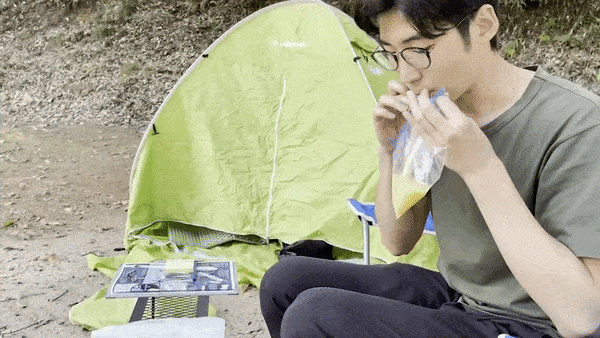◀︎ BLOG
Reimagining Space Travel: The Magic in the Mundane
Once, Frederik Pohl, famed science fiction author, left us pondering a nugget of wisdom: A good science fiction story should be able to predict not the automobile but the traffic jam. When dreaming up futures, we often overlook the very human challenges that such futures might present. But we need to remember, it's us people living there, muddling through the everyday problems that future tech will inevitably toss our way.
This holds true even when our future is projected into outer space.
The project team, from left: Tomoya Mori (Business Design Lead, IDEO Play Lab), Shintaro Chofuku (Engineer, JAXA), Mio Yokota (Communications Design Lead, IDEO Tokyo)
In October 2021, a rocket engineer from the Japan Aerospace Exploration Agency (JAXA) joined IDEO Tokyo for a month-long "cross-border study program”. This resulted in exploring the intriguing intersection of human-centered design and space exploration. The question at hand: what would space travel feel like when it's no longer just for astronauts but for the rest of us?
This posed a unique challenge: to reimagine space travel with a human touch, crafting an enjoyable experience for everyone, regardless of their physical abilities or cultural backgrounds.
Crafting the Future User Journey
At IDEO, we value creating new experiences by empathizing with users. But with space travel, we're dealing with a unique situation—the user may still be beyond our reach.
To envision the future of space travel in the most comprehensive manner, we leaned into expert interviews. These dialogues with specialists in various fields provided invaluable insights for designing future experiences and services.
We discovered from spacecraft engineers the mental and physical challenges astronauts face. An Experience Designer from IDEO's PlayLab further provided tips on how to craft experiences that preemptively mitigate discomfort.
What dawned on us was that space travel isn't just about the Overview Effect. It starts way before hitting the 'Book Now' button and lasts way after you're back on Mother Earth.
As the team conducted expert interviews, they began to depict the user journey of a space traveler.
Experiencing the Future
In our quest to enhance empathy, we devised a method to immerse ourselves in the user's world, to get under their skin and understand their experiences more intuitively. At IDEO, we call this the Empathy Exercise. As Bill Moggridge, one of the founders of IDEO and a product designer, succinctly put it, "The only way to experience an experience is to experience it." So, we thought, why not bring a taste of space right here on Earth? Thus, our makeshift 'space camp' was born, where we mimicked the space traveler's journey under as-real-as-it-gets conditions.
Our space camp menu? Only freeze-dried food to be rehydrated with hot water, akin to space cuisine. We rationed water, limiting each participant to 3.5L per day for cooking, drinking, and freshening up—just like on the International Space Station.
We even simulated the trials of toilet use in space. You see, in a spaceship, you've got to don diapers or use a wall-mounted toilet while other passengers are just a step away. During the camp, we used portable toilets for urination. For the other, ahem, business, we had a two-person arrangement in a private room: one person turns a blind eye while the other does their thing.
Food and supplies given to each person. Like actual space travel, they were allowed to choose their favorite freeze-dried food in advance.

An IDEO designer eating rice porridge with a tapioca straw.
While it may sound like a game at first, spending a whole day under these restrictions opened our eyes to various insights. For instance, the novelty of freeze-dried meals wore off after the first few bites. Eating straight from the package or ziplock bag was not only visually uninspiring but also cumbersome. So, we started getting creative with the packaging from the second meal onwards to make the food more palatable.
The bathroom experience was another big takeaway. In our daily grind, the loo is a private space, a welcome escape from the hustle and bustle. But in a cramped spaceship with no privacy, it's quite the stress-fest to hurry up to spare the waiting person and to keep any, well, olfactory offenses at bay.
Writing a 'One-Star Review' for Future Experiences
Our research revealed a number of human-centric problems hidden in space travel. To share these findings, we created a fictional news program from the future, featuring 'one-star reviews' penned by space travelers.
These fictional viral tweets aren't just complaints, but a launchpad for designing more enticing space travel experiences. By forecasting the everyday snags of a future where space travel is as common as a trip to Hawaii, we're one step closer to engineering a genuinely otherworldly experience.
Creating the Design Principles for the Future
Once challenges were identified, the impulse to dive straight into problem-solving was strong. However, at IDEO, we use 'Design Principles' to maintain our focus on the user's perspective.
For instance, our experience designer highlighted the need for psychological safety within a spaceship. Building trustful relationships is crucial for everyone to fully engage in the experience during space travel, where varied groups share a confined space.
We also learned from former astronaut Naoko Yamazaki about the value of fostering creativity. Space, free from gravity and conventional rules, allows for the redesign of norms. Rather than preparing all experiences in advance, we found that leaving room for travelers to create their own unique enjoyment might lead to more memorable journeys.
"If I had a free day in space, I'd want to make something. I'd create crystals, color soap bubbles, or use intense UV rays to create art pieces. Ideas for experiments in zero gravity are limitless." - Naoko Yamazaki
Ultimately, we crafted five core design principles, each considering various perspectives from physical fitness preparations for the journey to designing an inclusive spacecraft interior. As we begin to design concrete concepts, these principles serve as our compass, enabling us to continually envision a future of space travel that is fundamentally human-centric.
In these uncertain times, we must remember the people are always at the heart of our evolving narrative. As we dream, our focus should extend beyond technology to include the everyday challenges it brings along.
With a touch of creativity and a playful mindset, let's 'experience' this future together. The secret to a brighter tomorrow might well be hidden in the most mundane problems.
###
Learn more about the project at spacetravel.ideo.com. (Japanese Only)
Tomoya Mori
Business Design Lead, Play Lab
Tomoya is a business designer at IDEO Play Lab, where he works at the intersection of technology, science and business design. He is constantly looking out for hidden connections between seemingly unrelated subjects, and strives to turn them into viable and impactful innovation—be it new business models, experiences or brand strategies.
Rhianna Davies
Visual Communications Designer, Tokyo
Rhianna is a Visual Communications Designer at IDEO Tokyo. Her work focuses on using systematic storytelling to bring concepts to life through graphic design. She strives to create design languages that have strong roots in research, empathy and understanding.

